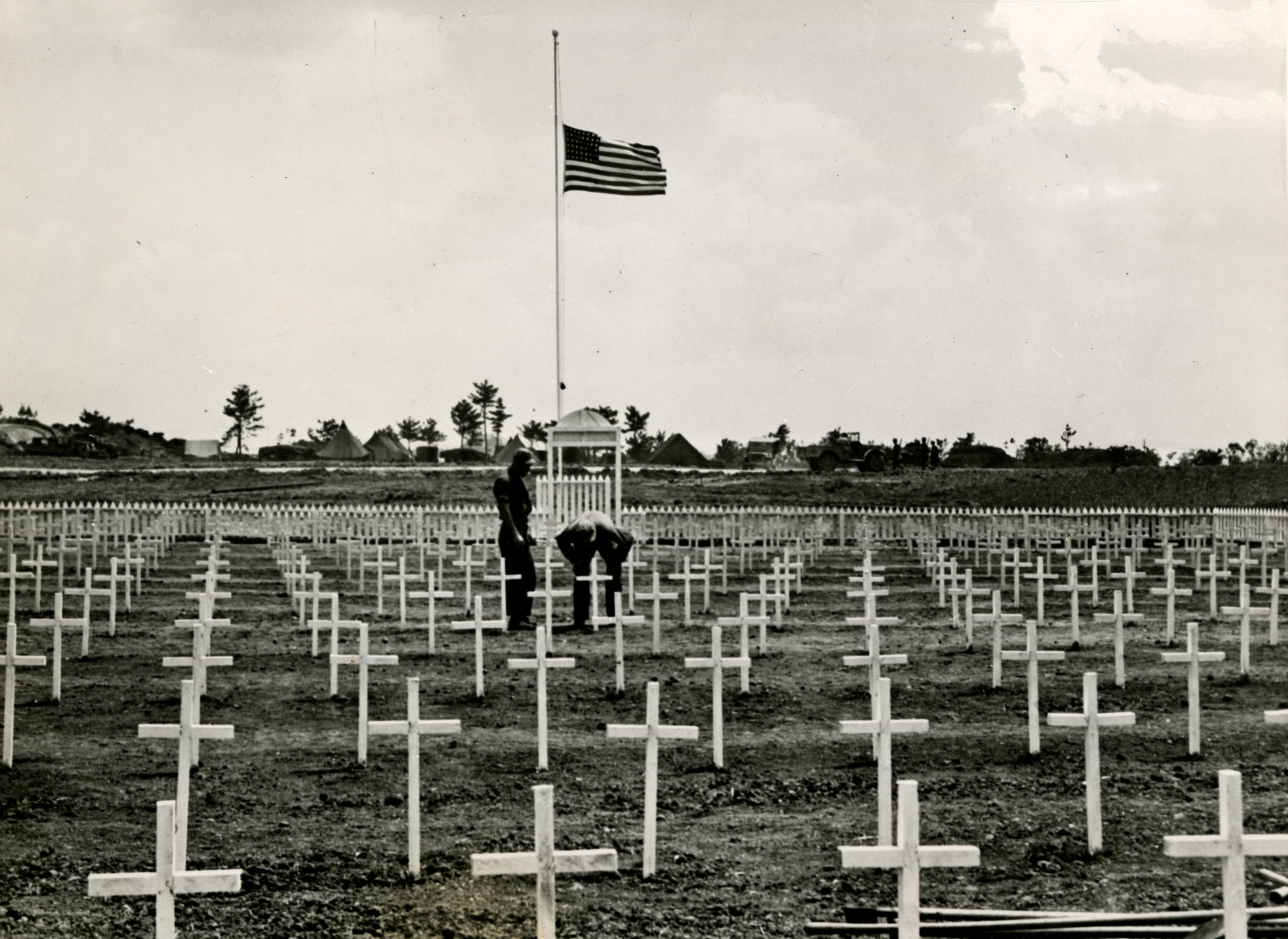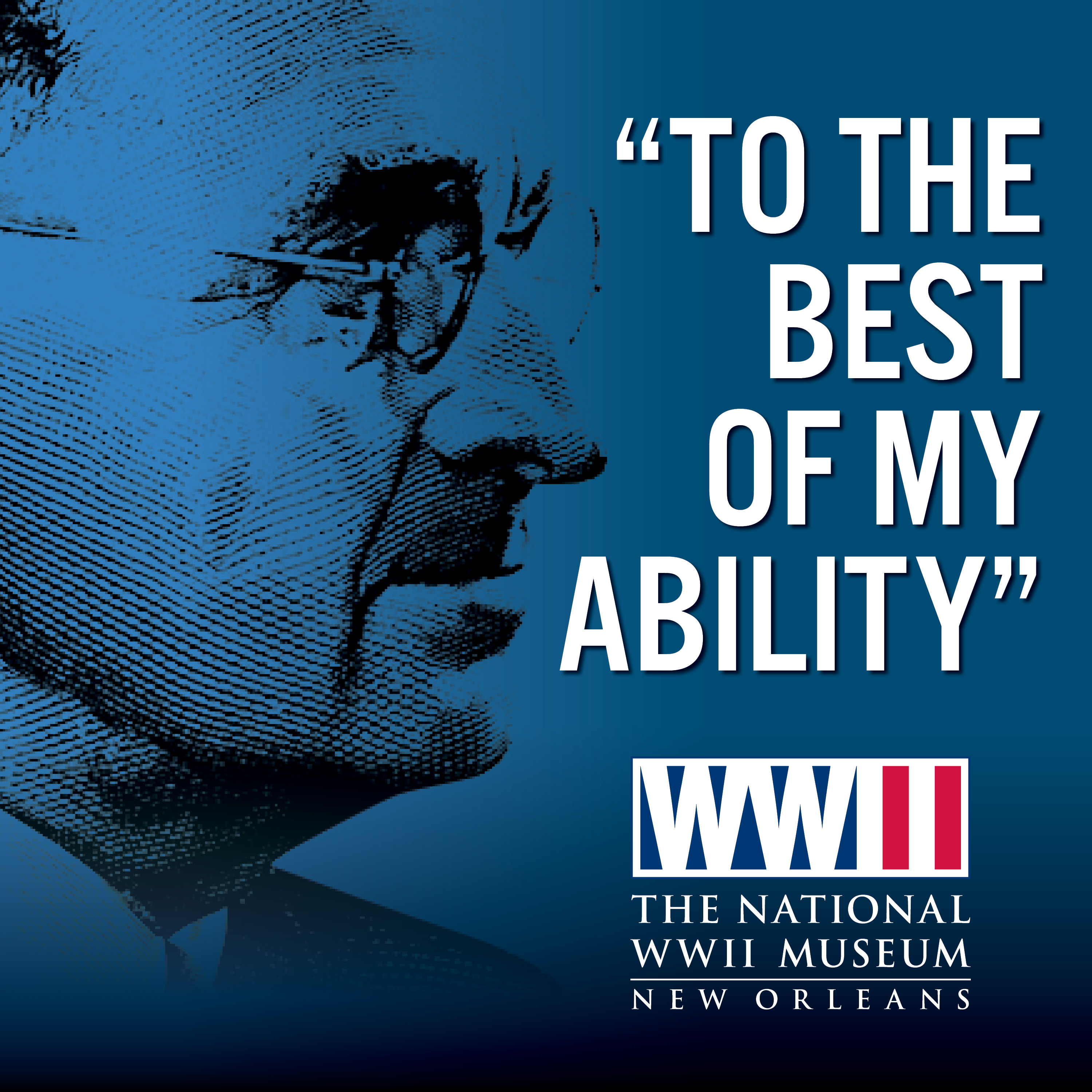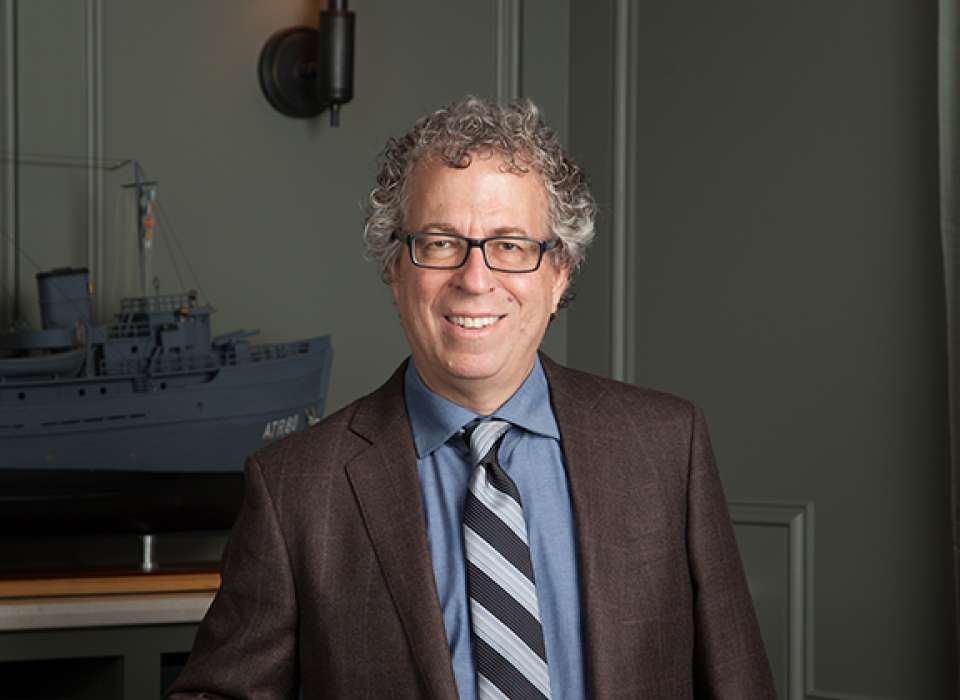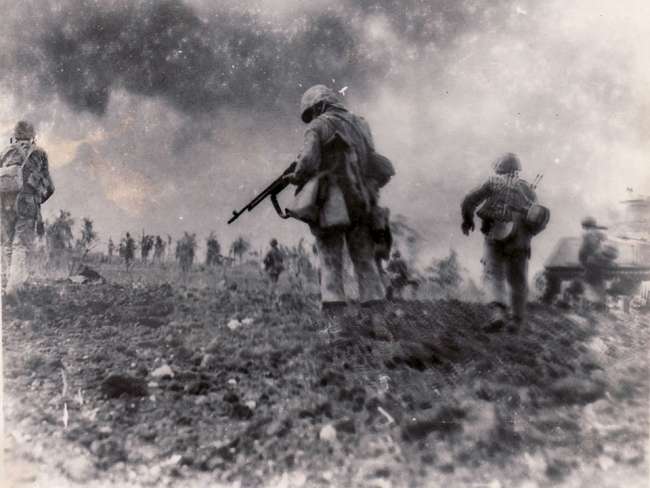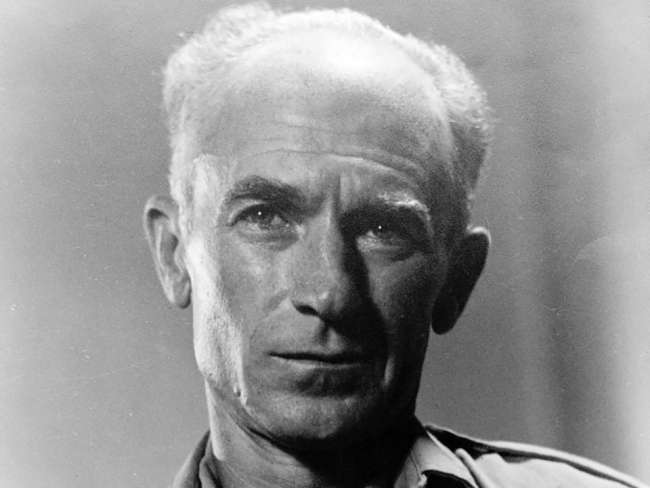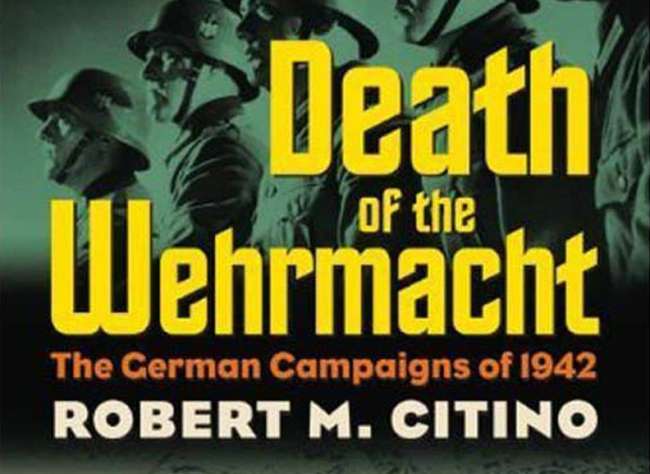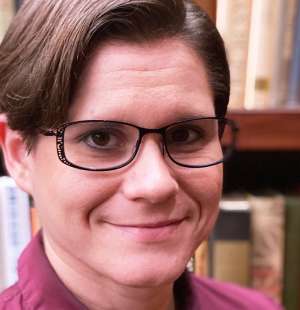Listen: Apple Podcasts, Spotify.
About the Episode
The war in Europe was over, but fighting raged in the Pacific. “We are only half-through,” Truman declares to the American people. He was right. The Battle of Okinawa (April 1 -- June 22, 1945) was one of the hardest-fought in the history of the US military. Okinawa is a mass of mountains, jungle, and mud, and the battle generated monstrous casualties on both sides: 93,000 Japanese, 12,000 US, and 140,000 Okinawan civilians. Just days into his presidency, Commander-in-Chief Truman was presiding over a bloodbath.
Hearing reports of the number of casualties had a tremendous impact on Truman. As he worked with Secretary of War Henry Stimson and the rest of his cabinet to determine a course of action in the Pacific, he heard estimates of additional casualties in the hundreds of thousands should the Americans need to launch a full-scale invasion of Japan. During these discussions, Stimson and Lieutenant General Leslie Groves would soon brief the President on “an explosive great enough to destroy the whole world.”
This episode, hosted by Dr. Kristen Burton and written by Gemma R. Birnbaum with additional support from Museum historian Seth Paridon, features first-hand accounts from the Museum’s oral history holdings. The first, a harrowing account from sailor Nolan Warren, who was serving aboard the USS Bunker Hill under the command of Admiral Marc Mitscher when the aircraft carrier was hit with a kamikaze attack. Next, listeners will hear from Eugene Disabatino, an engineer on the Manhattan Project who worked at the Los Alamos Laboratory in New Mexico. These interviews, conducted by historians Tommy Lofton and Joey Balfour respectively, are part of the Museum’s Digital Collections.
Topics Covered in this Episode
- The Battle of Okinawa
- First-Hand Accounts of the Japanese Kamikaze Attacks
- Task Force 58 and the USS Bunker Hill
- Strategic Importance of Okinawa
- The Manhattan Project and Los Alamos Operations
- J. Robert Oppenheimer, Lieutenant General Leslie Groves, and Enrico Fermi
- The Trinity Test in Alamogordo, New Mexico
Featured Historian
Dr. Robert M. Citino
Dr. Rob Citino is Executive Director of The National WWII Museum’s Institute for the Study of War and Democracy and the institution’s Samuel Zemurray Stone Senior Historian. Citino is an award-winning military historian and scholar who has published 10 books including The Wehrmacht Retreats: Fighting a Lost War, 1943, Death of the Wehrmacht: The German Campaigns of 1942, and The German Way of War: From the Thirty Years’ War to the Third Reich and numerous articles covering World War II and 20th century military history.
Related Content
-
Article Type
The Invasion of Okinawa: One Damned Ridge After Another
As Marines behind the lines ran supplies up to the grunts in the front, one survivor of the night action and a veteran of Peleliu was heard to tell his foxhole buddy about the upcoming fight, “This right here…well…this is gonna be a bitch.” He had no idea how accurate his prophecy would be.
-
Article Type
Ernie Pyle: The Voice of the American Soldier in World War II
Newspaper correspondent Ernie Pyle became a national folk hero by reporting on the average soldier in World War II.
-
-
Contributor
Kristen D. Burton, PhD
Kristen D. Burton is the Teacher Programs and Curriculum Specialist at The National WWII Museum in New Orleans, LA.
Sponsors
"To the Best of My Ability" is part of an ongoing series commemorating the 75th Anniversary of the End of World War II made possible by The Nierenberg Family and Bank of America.
Transcript
Archival Audio - Harry S. Truman Announces Germany’s Surrender
“Our victory is but half-won. The West is free, but the East is still in bondage to the treacherous tyranny of the Japanese. When the last Japanese division has surrendered unconditionally, then only will our fighting job be done.
“We must work to bind up the wounds of a suffering world—to build an abiding peace, a peace rooted in justice and in law. We can build such a peace only by hard, toilsome, painstaking work—by understanding and working with our allies in peace as we have in war.
“The job ahead is no less important, no less urgent, no less difficult than the task which now happily is done.
“I call upon every American to stick to his post until the last battle is won. Until that day, let no man abandon his post or slacken his efforts.”
Dr. Kristen Burton
When Truman assumed the Presidency in April 1945, the war in Europe was nearly over. Before month’s end, both Mussolini and Hitler were dead, the former killed by his own people, the latter a suicide. On May 8, the Allies accepted Germany’s unconditional surrender, ending a 12 year reign of Nazi terror.
Truman’s announcement to the American people was both celebratory and somber. He praised those who contributed to the war effort for this hard won victory, but he also urged perseverance. The war in the Pacific was not over, and was already taking an increasingly heavy toll on soldiers and civilians alike. Just days into his presidency, the new commander in chief was presiding over a bloodbath as the Battle of Okinawa, one of the hardest-fought in the history of the US military, generated mass casualties on both sides. By the time the fighting ended, more than 12,000 American servicemen, 93.000 Japanese soldiers, and 140,000 indigenous Okinawan civilians were dead.
While fighting raged on the island, back in Washington, Truman would meet with Secretary of War Henry Stimson and Lieutenant General Leslie Groves to learn more about a closely guarded military secret, something that he would later describe in his diary as, “an explosive great enough to destroy the whole world.”
Archival Audio
“I Harry S. Truman do solemnly swear to faithfully execute the Office of President of the United States, and will to the best of my ability, preserve, protect and defend the Constitution of the United States, so help me God.”
Dr. Kristen Burton
You’re listening to “To the Best of My Ability” from The National WWII Museum in New Orleans, and this is episode 2, “Death Stand.” I’m your host, Dr. Kristen Burton.
This week, we begin our story on the island of Okinawa.
Archival Audio - Newsreel Reporting on the Impending Invasion of Okinawa
(Triumphant music plays)
“The Admiral of the fleet Five Stars flying above the Pacific naval headquarters in Guam are ready to follow Admiral Nimitz, left, about to set out for the conquest of Okinawa. Coming aboard the flagship of task force 58 is Admiral Mitscher, scourge of the enemy in waters about Japan. Fourteen hundred ships get underway and the invasion forces the board cast worry aside for the moment and beat a tune out on the old squeeze box while Ernie Pyle, left. watches a fast stepping jitterbug run up a little hot rug cutting for the biggest invasion fleet ever assembled in the pacific. And if you're going to visit a foreign country, you've got to have native dough. Strategic Air fields are the objectives as the great fleet’s guns open up.”
(Canon Fire continues for several seconds)
Dr. Kristen Burton
On Easter Sunday 1945, more than 180,000 US Army and Marine Corps troops joined the Navy’s Fifth fleet in the Pacific theater's largest amphibious operation in what they hoped would be the final push towards Japan. Okinawa, an island known for harsh, rainy weather, dense foliage, rugged terrain on the island's ridges and coral elevations, and extreme heat and humidity, was a critical strategic location for the Japanese High Command due to its close proximity to the Home Islands. This was the same reason it was so important that the Americans -- Okinawa would be the ideal location for a staging point and resupply base for the upcoming invasion in addition to serving as a large medical facility for the massive casualties that were projected to come.
The Americans went into the assault with little to go on -- aerial recon was inadequate, and maps were largely inaccurate, putting them at a significant disadvantage. As the troops prepared to land on the beachheads, they braced themselves for an onslaught similar to what greeted the Allies at Normandy in 1944. Instead, wave after wave of troops made it ashore with relative ease, and within hours, had secured both Yontan and Kadena airfields.
Joining us once again is Dr. Rob Citino, Samuel Zemurray Stone Senior Historian and Executive Director of the Institute for the Study of War and Democracy at The National WWII Museum.
Dr. Rob Citino
So in the Pacific, the war has clearly entered the endgame. US troops were already deep in the planning cycle for the invasion of the big Japanese home islands—Kyushu, and Shikoku, and Honshu, where the vast majority of the Japanese live. But, of course, there’s intermediate targets on the way to the home islands, and there’s been a horrible battle that has already raged on Iwo Jima. And now there’s going to be one that’s just as bad, but much, much larger on the island of Okinawa.
So Allied troops land on Okinawa, and then the Japanese let them land. They can’t really, by this point in the war, contest every square inch of the coastline, even if they chose to. They let Americans land, and then as the Americans come deeper and deeper into Okinawa, a horrible fighting breaks out. The Japanese are there in force; they’re there in strength. They have honeycombed the entire island with machine gun positions, and mortar positions, artillery emplacements, underground tunnels, just as they had done in Iwo Jima.
Dr. Kristen Burton
After the early success of the landings and the relatively light resistance on the northern end of Okinawa, the fighting exploded with ferocity as Army and Marine units ran headlong into bristling, sophisticated Japanese defensive lines to the south. Okinawa's rugged terrain of coral ridge lines were perfect for defense, and Japanese General Mitsuru Ushijima's hardened troops turned the American advance into a slow, bloody slog. Weeks of horrendous fighting eventually turned the American's way, as the soldiers and Marines cleared what was left of the Japanese Shuri defensive line. Casualties on both sides were appalling due to the ferocious and close in fighting. Fighting was made even more difficult by torrential rainstorms and steep hills. The rain, many would recall after the battle, would sweep away dirt and debris to reveal unburied bodies lining the roads.
At sea, the Japanese resorted to kamikaze attacks on the vast Allied fleet, a tactic they had employed since October 1944, in which Japanese pilots would deliberately slam their aircraft into Allied ships in order to inflict as much damage, and casualties, as possible.
Oral History - Nolan Warren
But I remember the day we were—I think it was about—it was like a two or three-hundred-plane raid that left Japan the day we finally got hit.
Dr. Kristen Burton
Nolan Warren was a sailor aboard the aircraft carrier USS Bunker Hill, a part of Task Force 58, the immensely powerful US carrier fleet that ranged off of Japan's coast, under the command of Admiral Marc Mitscher. On May 11, 1945 the Bunker Hill was attacked by kamikazes.
Oral History - Nolan Warren
The ships were getting hit. I think history shows that we lost more people in the Okinawa campaign and the invasion right before it than the history of the United States all put together. A great percentage of that was all of the aircraft carriers, because when you hit the aircraft carrier, it’s like a bunch of bees on the deck. You know, I mean, you kill a hundred guys with one bomb—like that. It was a mess, and tremendous casualties in the carriers.
We had fought it all the way through, and had a lot of—a lot of near misses, a lot of adventures but hadn’t gotten a serious hit. Another thing that I’ll say that—that I remember distinctly also, we—a night before—a day or two before, at the most—it was the night before. I’ll exaggerate and make it a night before, it sounds better—Mitscher was aboard. It was the whole task groups—the whole taskforce. He’d had no communication with the ship, he was—that particular night, he gets on—on speaker, and—public speaker, and he says to the ship—because he couldn’t get to anybody else. “Gentlemen, I want you to know that I think it’s—we’re almost seeing the end of this.” He had gotten orders that something—Okinawa was getting—they’re going to be able to get planes on there and defend themselves and all that kind of—and I’ll never forget it because it—we were the only ones privy to this, but this was going to be the whole task group.
He said, “We have had this terrible ordeal. It’s been awful”—so many words. “I think we can see the light at the end of the tunnel. We hang in there for another couple of days, a week, we’re going to get some relief, finally. And I want you to know that I’m proud of this ship and proud of all the other guys in the Task Force who can’t hear me.” He made a nice little speech to us. Now, that’s something we were privy to that nobody else was. So we were all thinking, boy, maybe we’re going to finally get relieved and get back somewhere where we can go get a beer and—go somewhere for you to do something. I think it was the next day—the following day when we got hit. Of course, we lost almost 400 men that day, and another two or 300 terribly wounded. It was a gruesome affair.
Dr. Kristen Burton
In late May, the Americans took Shuri Castle, where the Japanese had set up their headquarters on the island, and the battle began to turn more staunchly in their favor. Following the collapse of the Shuri Line in May, the Japanese were pushed to the very southern coast of Okinawa where they were ultimately defeated.
While nearly 7,000 Japanese soldiers surrendered to the Americans, countless others instead chose to commit suicide, including General Ushijima and his chief of staff. On June 22, 1945, the island of Okinawa was declared secure, thus ending one of the bloodiest campaigns of the entire war.
Dr. Rob Citino
Like Iwo Jima before it, Okinawa demonstrated that there was no spot on planet Earth that the Japanese could defend if the Allies wanted to take it.
This is not just a great concentration of military force being arrayed against Japan. It’s taking place on Japan’s very doorstep. The next stop is literally Tokyo. The next stop is the island of Honshu. And so the fall of Okinawa, the mass destruction of property and loss of human life, the tens of thousands of civilian casualties on Okinawa, because there is large-scale Japanese settlement on Okinawa, the tens of thousands of Japanese civilians were a harbinger of what was to come if the Allies had ever decided to invade the Japanese home islands.
It’s clear that Truman was profoundly moved by the bloodshed on Okinawa, and he’s looking for a way to avoid that. What he wants to avoid, and he says this explicitly, is an invasion of Japan that turns into an Okinawa, from one end of the islands to other. That is, you know, one bloodbath after the other. Okinawa times 10, Okinawa times 100. He said this. He wanted to win the war. He knew that he did not have an unlimited amount of manpower, nor would the American people put up with hundreds of thousands of casualties and a war that appeared to be all but won. That would have been a difficult sell to the American people, and quite rightly.
So, I guess, looking at it from the Truman perspective, President Truman comes into office, and within weeks his forces—he’s now the commander-in-chief, and he’s a rookie commander-in-chief, he’s very aware of that—his men are now engulfed in a blood bath. Look, Truman has faith in his advisers, and they’ve certainly gotten US forces this far, and there’s no scenes of recrimination in the White House, so he’s well aware that there’s going to have to be blood shed before this war is over. But he also has an ace in the hole, which he’s been told about already. And that is this new device that US scientists are working on in the New Mexican desert.
Dr. Kristen Burton
While heading the Truman Committee -- an investigative body looking into war spending some years earlier --Truman had asked for more information about some puzzling budgetary items, only to have Secretary of War Henry Stimson intervene and refuse the request to allow the then-Senator and his committee to review it.
It wasn’t until after Truman became President that he learned where these large sums of money had been going -- almost immediately after he was sworn in, Stimson informed him that there was “a new and terrible weapon” that was being developed by scientists in the New Mexico desert. On April 24, Stimson and Lieutenant General Leslie Groves arrived at the White House with hundreds of reports detailing the Manhattan Project and its progress.
The United States was the only country with the resources to develop the bomb, they told him, and that while there was no chance that any of the Axis countries were even close to developing anything of this kind, Stalin and the Soviets might have access to atomic weapons within four years. Truman had to decide which -- if any -- of the Allies
should be told about the existence of this new weapon. The trio agreed to form a committee that would advise the President on use of the weapon, and he authorized them to continue on with its development.
Dr. Rob Citino
But, of course, you know, the Greeks believe in a goddess of history, Clio. She is the muse of history. She can be very playful, and she can play with the timeline and give you things when you least expect them that fulfill all your wishes in history. And for Truman and for the American military, it was this new explosive device known as the atomic bomb. It was the Manhattan Project. The Manhattan Project and the bomb that resulted from it could, in a single instant—as it turned out, it was two instants—erase the possibility of the nightmare of Harry Truman and the other US military planners.
Dr. Kristen Burton
The Manhattan Project is one of history’s greatest kept secrets. Even the thousands of workers across the country who were recruited for the project did not know that they were ultimately working towards the creation of warfare’s most powerful weapon.
Oral History - Eugene Disabatino
“I didn’t have any idea. I was put into a barracks and they just said ‘stay there’ a couple days. Then they came and got us and said come on we’re leaving and that was that, i had no idea what was going on at Oak Ridge. None.”
Dr. Kristen Burton
Eugene Disabatino was a member of the Special Engineer Detachment at Los Alamos during the Manhattan Project.
Oral History - Eugene Disabatino
It was typical of...of service in that particular situation, you wouldn’t believe it could happen, but you’d be standing in the middle of it and you wouldn’t really know what was happening. There was a lot happening that you didn't know about and yet you were part of it happening. So...I didn’t know what they were doing at Oak Ridge, I didn’t know what they were doing up in Los Alamos, I had no idea about anything. All I knew is what I was doing.
Within a couple days after we arrived and were screened by de Silva and warned about the security, we were all called to a big assembly room and the physicists who were listed that were at Los Alamos in those days came in and began to interview. And these physicists had a list of people in their hands and they would call a name and whoever the person was would go out and they’d have an interview and they would decide where this guy or girl was gonna be assigned. In my case, they got all the way down and i was the last one in the room when Norman Ramsey walked in the room and said “you’re a civil engineer. I don’t know what we’re gonna do with you.”
Dr. Kristen Burton
Disabatino would learn later that evening from physicist Norman Ramsey that they were working on what was only referred to as “a big bomb,” and that his skills as a civil engineer would best be put to use by joining the Delivery Group. He began work to develop the method by which the bomb would be dropped.
Theoretical physicist J. Robert Oppenheimer, director of the Los Alamos Laboratory, had brought together some of the greatest minds in physics to work on the bomb. He managed more than 3,000 people, each working towards a common goal. Their years of work came to fruition on July 16, 1945 in a remote desert location near Alamogordo, New Mexico that Oppenheimer named “Trinity.” Anxiety was running high as Oppenheimer, joined by scientists Enrico Fermi and Vannavar Bush, as well as General Groves, prepared to detonate the first atomic bomb. At 5:30am, the bomb went off.
Archival Audio - Sound of Nuclear Explosion
Dr. Kristen Burton
An intense flash of light and heat followed by a giant fireball tearing through the sky stretched into a mushroom cloud more than 40,000 feet across.
“The test was successful beyond the most optimistic expectations of anyone,” wrote Groves in his report. “Based on the data which it has been possible to work up to date, I estimate the energy generated to be in excess of the equivalent of 15,000 to 20,000 tons of TNT; and this is a conservative estimate.”
Truman was extremely anxious to hear whether or not the Trinity Test was successful. He learned of the test’s success while he was attending the Potsdam Conference, and as estimates of loss of life in the event of a full-scale invasion of the Japanese home islands consumed his thoughts, it was then that Truman approved the use of the bomb against Japan.
Some weeks earlier, Stimson had advised Truman that such a bomb, if successful, might also prove to be useful in intimidating Soviet leader Joseph Stalin as he continued his quest for post-war Communist expansion throughout Eastern Europe.
In his diary, Truman wrote:
“We have discovered the most terrible bomb in the history of the world. This weapon is to be used against Japan between now and August 10th. I have told the Secretary of War, Mr. Stimson, to use it so that military objectives and soldiers and sailors are the target and not women and children. Even if the Japs are savages, ruthless, merciless and fanatic, we as the leader of the world for the common welfare cannot drop that terrible bomb on the old capital or the new.
“He and I are in accord. The target will be a purely military one and we will issue a warning statement asking the Japs to surrender and save lives. I’m sure they will not do that but we will have given them the chance. “
“It is certainly a good thing that Hitler’s crowd or Stalin’s did not discover this atomic bomb. It seems to me the most terrible thing ever discovered, but it can be made the most useful.”
Dr. Rob Citino
Truman, as commander-in-chief, actually has—is a bigger story than World War II. He’s going to be the commander-in-chief in Korea, as well. And I guess taken together, I would say Truman was an extremely effective commander-in-chief in that he inherited a situation in 1945 of enormous complexity, in which the plans for victory were pretty well worked out, and he allowed them to ride, not feeling any—a compulsion to put his stamp on the course of events, as is natural for some presidents. Here you’re president of the United States, and you’re the commander-in-chief, and you want to make sure that your prerogatives are, you know, are being granted and that your words are being heard.
I think Truman understood the nature of modern war as well as any president, and I know this. When we read his memoirs, he talks about reading the great Prussian philosopher of war in the early nineteenth century, Carl von Clausewitz. Clausewitz wrote a piece, Vom Kriege, in German, On War, as it’s usually translated into English, in which he laid down, you know, the basic aphorism, which I think is still so true, that war is the continuation of politics by other means. Now, sometimes people take that to mean, well, once war starts, then you hand it over to the generals. That’s not what Clausewitz meant, and it’s clear from Truman’s discussion of Clausewitz in his memoirs that he clearly understood what Clausewitz was saying, and that is this. That you fight a war so that at the end of the war you’re in better shape than you were at the beginning, that war has to have a political aim.
Dr. Kristen Burton
In our next episode, “Supreme Authority,” we’ll conclude our time with Dr. Rob Citino as we explore how the Allies navigated the governing of a postwar Germany, with the US, UK, USSR, and France jointly assuming supreme authority over German territory.
From The National WWII Museum, I’m Dr. Kristen Burton. This episode was written by our executive producer Gemma R. Birnbaum. Media production manager Jeremy Burson did the sound mixing. Archival audio is courtesy of the National Archives. Oral history segments are from the Digital Collections of The National WWII Museum. Segments read from Truman’s diary are courtesy of the Harry S. Truman Library.
If you like this podcast, please rate and review us on Apple Podcasts, which helps others to find the series. "To the Best of My Ability" is part of an ongoing series of programs commemorating the 75th Anniversary of the End of World War II made possible by The Nierenberg Family and Bank of America.
